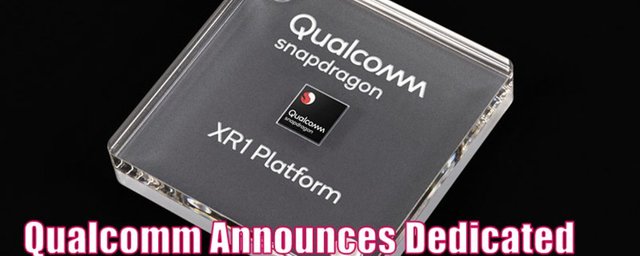
Leading global designer and manufacturer of System on Chip (SoC) for smartphones, Qualcomm has announced the company is working on a dedicated VR/AR chip which goes by the name of Snapdragon XR1. It should be noted that many VR headsets today already use Qualcomm's SoCs but those chips are generally geared toward smartphones such as Snapdragon 821 and 835 chips.
Dubbed first dedicated XR platform (Augmented plus Virtual Reality) by Qualcomm, the XR1 chip is in development specifically for Augmented and Virtual Reality devices. The SoC giant revealed their plans for this latest platform in a press event held in Silicon Valley.
What separates the chip from others is that Qualcomm is targetting high quality devices instead of the premium ones. It means that the chip will be suitable for use not only in high-end VR gear but budget friendly headsets as well such as Oculus Go. The company spokesperson elaborated that they want to help in taking the Virtual Reality technology mainstream so everyone can reap its benefits.
Moreover, the San Diego based chipmaker also unveiled that big players like Vuzix, Pico and HTC are already working on XR1 based VR/AR devices. Currently on low end or budget friendly hardware we don't have 6DoF tracking which compromises the quality of VR experience. One of the leading advantages that XR1 will bring is it'll enable the OEMs of VR headsets to support both 6DoF and 3DoF tracking for hands and head. The OEM can make their choice depending on what they want to achieve with their VR device.
According to Alex Katouzian, the senior vice president and general manager of the Mobile Business Unit of Qualcomm Technologies:
“As technology evolves and consumer demand grows, we envision XR devices playing a wider variety of roles in consumers’ and workers’ daily lives. By integrating powerful visuals, high-fidelity audio, and rich interactive experiences, XR1 will help create a new era of high-quality, mainstream XR devices for consumers."
The Snapdragon XR1 platform is fundamentally revolutionizing three major aspects of Virtual and Augmented Reality experience – what you see, what you hear, and how you interact. Here is a brief introduction to all three components of the platform.
Visual Innovation
The Snapdragon XR1 will empower buyers to be inundated in their most loved motion pictures, projects and games with 4K video compatibility up to 60 fps for astounding VR Head Mounted Displays (HMDs. New devoted equipment and clever algorithms inside its Qualcomm Spectra™ Image Signal Processor (ISP) are capable of providing assistance in alleviating undesirable noise from picture delivering a considerably enhanced final result in top notch AR/VR headsets.
There is also an integrated display processor which gives users a choice between display options such as 3D overlays, dual display support, hardware accelerated composition, and support for popular Application Programming Interfaces (API), including OpenGL, OpenCL and Vulkan. The XR1 platform likewise includes advanced vision processing ability for innovations like Visual Inertial Odometry (VIO), which gives users a chance to move around in the virtual world or communicate with augmented objects in an Augmented Reality encounters.
Enhanced Sound
Qualcomm’s Snapdragon XR1 platform utilizes Qualcomm Technologies 3D Audio Suite, Qualcomm Aqstic™ Audio Technologies, and Qualcomm® aptX™ Audio for high-fidelity sound encounters and "always on, always listening" voice help as well as high quality Bluetooth playback.
Snapdragon XR1's head-related transfer functions (HRTF) empower user’s ears to blend binaural sound that feels like it originates from a particular point in space.
Interaction with Augmented/Virtual Reality
Equipped with both 3DoF and 6DoF head tracking and controller abilities for Augmented and Virtual Reality headsets, XR1 opens a radical new XR play area for regular users. The new interactive technology lets them not just move unreservedly in the virtual world more than ever but additionally communicate and play inside it as well.
An integrated sensor hub and improved sensor combination capacities enable clients to encounter rich collaborations with movement to photon latencies well underneath the experimentally required 20ms.
This can prove to be a pivotal moment in Virtual Reality as more capable technology laden with features accessible to mass market at an affordable cost can really boost the adoption of the VR into the next orbit.
Originally Published at Maxbox VR: https://bit.ly/2LFlZIE